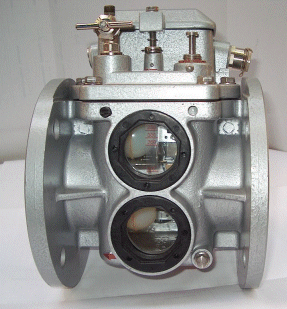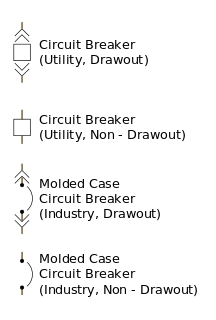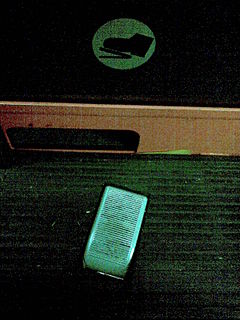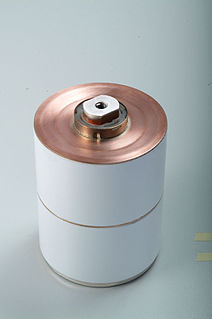 W
WAn arc-fault circuit interrupter (AFCI) also known as an arc-fault detection device (AFDD) is a circuit breaker that breaks the circuit when it detects an electric arc in the circuit it protects to prevent electrical fires. An AFCI selectively distinguishes between a harmless arc, and a potentially dangerous arc.
 W
WA kill switch, also known as an emergency stop (E-stop), emergency off (EMO) and as an emergency power off (EPO), is a safety mechanism used to shut off machinery in an emergency, when it cannot be shut down in the usual manner. Unlike a normal shut-down switch or shut-down procedure, which shuts down all systems in order and turns off the machine without damage, a kill switch is designed and configured to abort the operation as quickly as possible and to be operated simply and quickly. Kill switches are usually designed to be noticeable, even to an untrained operator or a bystander.
 W
WIn electric power distribution and transmission, a Buchholz relay is a safety device mounted on some oil-filled power transformers and reactors, equipped with an external overhead oil reservoir called a "conservator".
 W
WA circuit breaker is an automatically operated electrical switch designed to protect an electrical circuit from damage caused by excess current from an overload or short circuit. Its basic function is to interrupt current flow after a fault is detected. Unlike a fuse, which operates once and then must be replaced, a circuit breaker can be reset to resume normal operation.
 W
WA dead man's switch is a switch that is designed to be activated or deactivated if the human operator becomes incapacitated, such as through death, loss of consciousness, or being bodily removed from control. Originally applied to switches on a vehicle or machine, it has since come to be used to describe other intangible uses like in computer software.
 W
WAn Earth-leakage circuit breaker (ELCB) is a safety device used in electrical installations with high Earth impedance to prevent shock. It detects small stray voltages on the metal enclosures of electrical equipment, and interrupts the circuit if a dangerous voltage is detected. Once widely used, more recent installations instead use residual-current devices which instead detect leakage current directly.
 W
WIn electrical distribution, a fuse cutout or cut-out fuse is a combination of a fuse and a switch, used in primary overhead feeder lines and taps to protect distribution transformers from current surges and overloads. An overcurrent caused by a fault in the transformer or customer circuit will cause the fuse to melt, disconnecting the transformer from the line. It can also be opened manually by utility linemen standing on the ground and using a long insulating stick called a "hot stick".
 W
WAn inertial switch is a switch, firmly mounted upon a vehicle or other mobile device, that triggers in the event of shock or vibration. It is a part of electrical circuits that may either enable or disable some function.
 W
WA kill switch, also known as an emergency stop (E-stop), emergency off (EMO) and as an emergency power off (EPO), is a safety mechanism used to shut off machinery in an emergency, when it cannot be shut down in the usual manner. Unlike a normal shut-down switch or shut-down procedure, which shuts down all systems in order and turns off the machine without damage, a kill switch is designed and configured to abort the operation as quickly as possible and to be operated simply and quickly. Kill switches are usually designed to be noticeable, even to an untrained operator or a bystander.
 W
WIn electrical engineering a limit switch is a switch operated by the motion of a machine part or presence of an object.
 W
WAn oxygen firebreak, also known as a fire stop valve or fire safety valve, is a thermal fuse designed to extinguish a fire in the delivery tube being used by a patient on oxygen therapy and stop the flow of oxygen if the tube is accidentally ignited. Oxygen firebreaks are fitted into the oxygen delivery tubing close to the patient, typically around the patient's sternum where the two nasal cannula tubes join and connect to the delivery tubing.
 W
WIn electric power distribution, automatic circuit reclosers (ACRs) are a class of switchgear which is designed for use on overhead electricity distribution networks to detect and interrupt momentary faults. Also known as reclosers or autoreclosers, ACRs are essentially high voltage rated circuit breakers with integrated current and voltage sensors and a protection relay, optimized for use as an overhead network distribution protection asset. Commercial ACRs are governed by the ANSI/IEEE C37.60, IEC 62271-111 and IEC 62271-200 standards. The three major classes of operating voltage are 15.5 kV, 27 kV and 38 kV.
 W
WA residual-current device (RCD), residual-current circuit breaker (RCCB), or ground-fault circuit interrupter (GFCI) is a device that quickly breaks an electrical circuit to prevent serious harm from an ongoing electric shock. Injury may still occur in some cases, for example if a human falls after receiving a shock, or if the person touches both conductors at the same time which an RCD won't prevent.
 W
WA scram or SCRAM, also known as AZ-5, is an emergency shutdown of a nuclear reactor effected by immediately terminating the fission reaction. It is also the name that is given to the manually operated kill switch that initiates the shutdown. In commercial reactor operations, this type of shutdown is often referred to as a "SCRAM" at boiling water reactors (BWR), a "reactor trip" at pressurized water reactors (PWR) and EPIS at a CANDU reactor. In many cases, a SCRAM is part of the routine shutdown procedure, which serves to test the emergency shutdown system.
 W
WSifa is a type of deadman's control system used on German-influenced European railways. Although deadman's pedals are commonly used on railways worldwide, Sifa systems are specifically those codified by German Industrial Norms VDE 0119-207-5.
 W
WSulfur hexafluoride circuit breakers protect electrical power stations and distribution systems by interrupting electric currents, when tripped by a protective relay. Instead of oil, air, or a vacuum, a sulfur hexafluoride circuit breaker uses sulfur hexafluoride (SF6) gas to cool and quench the arc on opening a circuit. Advantages over other media include lower operating noise and no emission of hot gases, and relatively low maintenance. Developed in the 1950s and onward, SF6 circuit breakers are widely used in electrical grids at transmission voltages up to 800 kV, as generator circuit breakers, and in distribution systems at voltages up to 35 kV.
 W
WA thermal cutoff is an electrical safety device that interrupts electric current when heated to a specific temperature. These devices may be for one-time use, or may be reset manually or automatically.
 W
WIn electrical engineering, a vacuum interrupter is a switch which uses electrical contacts in a vacuum. It is the core component of medium-voltage circuit-breakers, generator circuit-breakers, and high-voltage circuit-breakers. Separation of the electrical contacts results in a metal vapour arc, which is quickly extinguished. Vacuum interrupters are widely used in utility power transmission systems, power generation unit, and power-distribution systems for railways, arc furnace applications, and industrial plants.